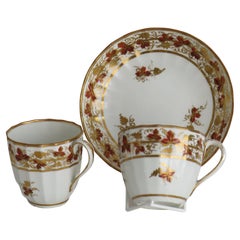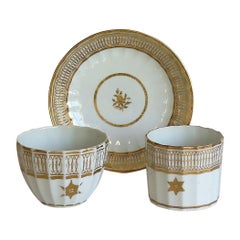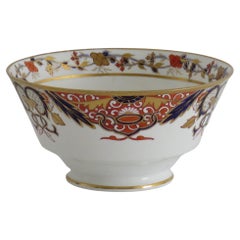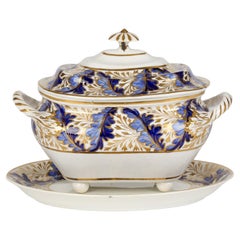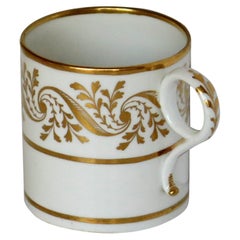George III Porcelain
to
2
115
57
58
385
381
299
240
233
227
200
172
149
142
116
93
91
37
22
9
7
5
115
113
1
1
101
12
112
111
79
2
1
115
115
115
9
8
8
5
3
Style: George III
Fine Georgian period Minton Porcelain Coffee Can Pattern 641, Circa 1805
By Minton
Located in Lincoln, Lincolnshire
This is a finely painted porcelain coffee can made by the Minton factory, England, in the reign of George 111 in the early 19th century, circa 1805
Straight sided coffee cans wer...
Category
Early 19th Century English Antique George III Porcelain
Materials
Porcelain
Georgian Derby Trio Tea & Coffee Cup & Saucer Pattern 569, Puce Mark Circa 1795
By Derby
Located in Lincoln, Lincolnshire
This is a good porcelain TRIO of a Tea Cup, Coffee Cup and saucer by the Derby factory, made during the George 111rd period, circa 1795.
The pieces are well potted in the Hamilton...
Category
Late 18th Century British Antique George III Porcelain
Materials
Porcelain
John Rose Coalport TRIO Porcelain Gilded Royal Garter Pattern, Circa 1800
Located in Lincoln, Lincolnshire
This is an early porcelain trio comprising a coffee can, tea cup and saucer, all in gilded patterns, which we attribute to Coalport, John Rose & Co., Shropshire, England, made at the...
Category
Late 18th Century English Antique George III Porcelain
Materials
Porcelain
Early 19th Century Spode Porcelain Slop Bowl in Japan Ptn 1946, circa 1810
By Josiah Spode
Located in Lincoln, Lincolnshire
This is a very good rare example of an English George III period, porcelain, slop bowl, made by Spode in the early 19th century, circa 1810.
The bowl is well potted on a low everted...
Category
Early 19th Century English Antique George III Porcelain
Materials
Porcelain
Derby Porcelain Works Leaf Pattern Lidded Sucrier and Stand
Located in Bishop's Stortford, Hertfordshire
A stylish English Georgian porcelain lidded twin handled sucrier and stand decorated in a leaf pattern by Derby Porcelain Works and dating from around 1820. The rounded shaped rectan...
Category
1820s English Antique George III Porcelain
Materials
Porcelain
Georgian Worcester BF&B Porcelain Coffee Can in Hand Gilded Pattern, circa 1810
Located in Lincoln, Lincolnshire
This is a very good quality coffee can in a hand gilded pattern made by Worcester during the Barr, Flight & Barr period (BFB) of George 111rd years, circa 1807-1813.
The coffee ca...
Category
Early 19th Century English Antique George III Porcelain
Materials
Porcelain
Georgian Derby Coffee Can Hand Painted Roses by John Stanesby, Circa 1810
Located in Lincoln, Lincolnshire
This is a beautiful porcelain Coffee Can by the Derby factory, made during the late Georgian period of the early years of the 19th Century
The cylindrical can tapers slightly to the...
Category
Early 19th Century British Antique George III Porcelain
Materials
Porcelain
Spode Porcelain Tea Cup in Hand Painted & Gilded Pattern 967, circa 1810
By Spode
Located in Lincoln, Lincolnshire
This is a fine example of an English George III period, porcelain Tea Cup, made by Spode and hand painted in Pattern 967, during the early 19th century, circa 1815.
The cup has th...
Category
Early 19th Century English Antique George III Porcelain
Materials
Porcelain
Early 19th Century Spode Porcelain Slop Bowl in gilded Pattern 2214, Ca 1810
By Josiah Spode
Located in Lincoln, Lincolnshire
This is a very good rare example of an English George III period, porcelain, slop bowl, made by Spode in the early 19th century, circa 1810.
The bowl is well potted on a low everted...
Category
Early 19th Century English Antique George III Porcelain
Materials
Porcelain
Georgian Miles Mason Porcelain Deep Plate or Dish hand painted Ptn 153, Ca 1805
Located in Lincoln, Lincolnshire
This is a porcelain, hand painted and gilded deep plate or saucer dish made by Miles Mason (Mason's), Staffordshire Potteries, England in the very early years of the 19th century, Ge...
Category
Early 19th Century English Antique George III Porcelain
Materials
Porcelain
Worcester Barr Flight & Barr Period Porcelain Tea Cup & Saucer Duo, circa 1810
Located in Lincoln, Lincolnshire
This is a a good early tea cup and saucer duo, hand decorated with a leaf and gilt intertwining pattern by Worcester during the Barr / Barr, Flight and Barr period, fully marked to ...
Category
Early 19th Century English Antique George III Porcelain
Materials
Porcelain
Swansea Welsh Pair Famille Rose Chinese Mandarin Pattern Porcelain Cups
Located in Bishop's Stortford, Hertfordshire
A rare and early pair Swansea, Welsh, hand painted porcelain breakfast cups hand painted in the Chinese famille rose style with the Mandarin pattern d...
Category
1810s Welsh Antique George III Porcelain
Materials
Porcelain
Early English Pair Porcelain Imari Pattern Cabinet Plates c.1810
Located in Bishop's Stortford, Hertfordshire
A very stylish and fine pair of early English porcelain plates hand decorated in the Imari style and dating from around 1810. The plates of rou...
Category
1810s English Antique George III Porcelain
Materials
Porcelain
Worcester Coffee Cup, Monochrome Black Print "Tea Party no.3", Georgian ca 1760
Located in London, GB
This is a very charming coffee cup and saucer made by Worcester in their First Period (sometimes called the Dr Wall Period) in about 1760. The items are decorated in a black overglaz...
Category
1760s English Antique George III Porcelain
Materials
Porcelain
Antique French or German Porcelain Snuff Box with Hand-Painted Military Scenes
Located in Philadelphia, PA
A fine antique French or German porcelain snuff box.
Dating to the 18th (or possibly early 19th) century.
Decorated throughout with...
Category
18th Century German Antique George III Porcelain
Materials
Porcelain
Worcester Barr Period Porcelain Coffee Can trailing vine pattern, circa 1807
Located in Lincoln, Lincolnshire
This is a good early Coffee Can or cup with a ring handle, hand decorated with a leaf and gilt intertwining pattern by Worcester during the Barr, Flight and Barr period, fully marked to the base and dating to circa 1807-1813.
The piece is well potted with nominally parallel sides and a ring handle.
The pattern is hand painted with an intertwining Meander pattern of brown leaves and gilding with additional gilding to the outer handle. Similar coffee cans are illustrated in the book A Compendium of British Cups by Michael Berthoud .
The base has a scratched "B" to the base indicating it was potted in the Worcester Barr...
Category
Early 19th Century English Antique George III Porcelain
Materials
Porcelain
Georgian Derby Cup and Saucer Duo in Pattern 561, Puce Mark Circa 1800
By Derby
Located in Lincoln, Lincolnshire
This is a good porcelain duo of a cup and saucer by the Derby factory, made during the George 111rd period, circa 1800.
Both pieces are well potted in the Hamilton flute shape wit...
Category
Early 19th Century British Antique George III Porcelain
Materials
Porcelain
Early Derby Porcelain Cup & Saucer Rare Pattern 128 Puce Crown Marks, circa 1795
Located in Lincoln, Lincolnshire
This is a late 18th century porcelain Tea Cup and Saucer in pattern 128 by the Derby factory, Circa 1795.
This is a rare Derby pattern that we have not come across or seen previou...
Category
Late 18th Century English Antique George III Porcelain
Materials
Porcelain
Derby Imari Pattern Partners Porcelain Inkwell and Quill Pen Stand
By Derby
Located in Bishop's Stortford, Hertfordshire
A very fine, rare and unusual antique English Derby partners porcelain inkwell and quill pen holder decorated in the Imari pattern and dating from the early ...
Category
Early 19th Century English Antique George III Porcelain
Materials
Porcelain
English Porcelain London Shape Imari Painted Jug
Located in Bishop's Stortford, Hertfordshire
A fine quality antique English porcelain, possibly Coalport, London shape sauce jug decorated in an Imari pattern and dating from around 1810. The sauce jug is lightly potted and is ...
Category
Early 19th Century English Antique George III Porcelain
Materials
Porcelain
Welsh or English Floral Hand Painted Porcelain Serpent Handle Jug and Stand
Located in Bishop's Stortford, Hertfordshire
A very finely made antique Welsh or English floral painted porcelain serpent handled jug with fitted stand dating from the early 19th century. The set comprises of a hexagonal shaped...
Category
1820s British Antique George III Porcelain
Materials
Porcelain
Swansea Welsh Porcelain Kingfisher Pattern Cabinet Trio
Located in Bishop's Stortford, Hertfordshire
A fine antique Welsh porcelain cabinet trio decorated in the Kingfisher pattern by sought after maker Swansea and dating from around 1820. The trio comprises of a teacup, a coffee cu...
Category
1820s Welsh Antique George III Porcelain
Materials
Porcelain
Derby Dolphin & Shell Molded Porcelain Butter Boat Circa 1770
By Derby
Located in Bishop's Stortford, Hertfordshire
A fine antique Georgian English porcelain Dolphin and Shell molded butter boat by Derby and dating from around 1770. The small jug shaped vessel sta...
Category
18th Century English Antique George III Porcelain
Materials
Porcelain
Worcester Porcelain Deep Plate, Aesop Fable Horse and Donkey, ca 1780
Located in London, GB
This is a very rare deep plate made by Worcester around 1780. The plate has a basket weave rim and a very charming image of the Aesop fable of the horse and the donkey in the centre....
Category
1780s English Antique George III Porcelain
Materials
Porcelain
Worcester Porcelain Deep Plate, Aesop Fable Three Foxes, ca 1780
Located in London, GB
This is a very rare deep plate made by Worcester around 1780. The plate has a basket weave rim and a very charming image of an Aesop fable about three foxes conversing under a large ...
Category
1780s English Antique George III Porcelain
Materials
Porcelain
Worcester Porcelain Blue Scale Junket Dish, c1770
Located in Tunbridge Wells, GB
Worcester Porcelain Blue Scale Junket Dish, c1770
Additional information:
Date : c1770
Period : George III
Marks :Square seal mark
Origin : W...
Category
18th Century English Antique George III Porcelain
Materials
Porcelain
Caughley Porcelain Teapot, Pink Floral Compagnie des Indes, ca 1785
Located in London, GB
This is a beautiful teapot made by Caughley around 1785, decorated with the "Compagnie des Indes" pattern with bold pink flower sprays and a pink s...
Category
1780s English Antique George III Porcelain
Materials
Porcelain
A Giles Decorated Worcester Lady Mary Wortley Deep Plate, c1770
By 1st Period Worcester Dr. Wall, James Giles
Located in Tunbridge Wells, GB
A Giles Decorated Worcester Lady Mary Wortley Deep Plate, c1770
Additional information:
Date : 1768-1773
Period : George III
Marks : Underglaze blue square seal mark
Origin : Worces...
Category
18th Century English Antique George III Porcelain
Materials
Porcelain
Nantgarw Porcelain Dinner Plate, c1820
Located in Tunbridge Wells, GB
Nantgarw Porcelain Dinner Plate, c1820
Additional information:
Date : c1820
Period : George III/George IV
Marks : Impressed NANT-GARW C.W.
Origin : Nantgarw, South Wales
Colour : o...
Category
19th Century English Antique George III Porcelain
Materials
Porcelain
Pair of 19th Century Spode Porcelain Ice-Pails
By Spode
Located in London, GB
An early 19th century pair of porcelain ice-pails with gilt leaf decorated borders, part of a dessert service, comprising 20 plates, 3 shell dishes, 3 circul...
Category
Early 19th Century English Antique George III Porcelain
Materials
Porcelain
$5,909 / set
Worcester Porcelain Twig Handle Blue Scale Leaf Dish c1775
Located in Tunbridge Wells, GB
Heading : Worcester porcelain blue scale leaf dish
Date : c1775
Period : George III
Marks : Pseudo fret square
Origin : Worcester, England
Colour : Polychrome
Pattern : Blue scale m...
Category
1770s British Antique George III Porcelain
Materials
Porcelain
Worcester Porcelain Sweetmeat Dish Queens Pattern Blind Earl c1775
Located in Tunbridge Wells, GB
Heading : Worcester porcelain Queen's pattern Blind Earl
Date : c1775
Period : George III
Marks :Pseudo fret square
Origin : Worcester, England
Colour : Polychrome
Pattern : Queen's...
Category
1770s British Antique George III Porcelain
Materials
Porcelain
Worcester Blue Scale Leaf Dish, c1775
Located in Tunbridge Wells, GB
Worcester Blue Scale Leaf Dish, c1775
Additional information:
Date : c1775
Period : George III
Marks : Worcester pseudo fret square
Origin : Worcester,...
Category
18th Century English Antique George III Porcelain
Materials
Porcelain
22121706 Swansea Porcelain Dessert Plate By Henry Morris, c1816
Located in Tunbridge Wells, GB
22121706 Swansea Porcelain Dessert Plate By Henry Morris, c1816
Additional information:
Date : 1815-1817
Period : George III
Marks : none
Origin : Swansea, South Wales
Colour : poly...
Category
19th Century English Antique George III Porcelain
Materials
Porcelain
Very Rare Form Worcester Chocolate Cup and Saucer, c1775
Located in Tunbridge Wells, GB
Very Rare Form Worcester Chocolate Cup and Saucer, c1775
Additional information:
Date : 1765-85
Period : George III
Marks : Square seal mark
Origin : Worcester, England
Colour : Und...
Category
18th Century English Antique George III Porcelain
Materials
Porcelain
Worcester Porcelain Queen's Pattern Fluted Coffee Cup and Saucer c1775
Located in Tunbridge Wells, GB
Heading : Worcester porcelain Queen's pattern coffee cup and saucer
Date : c1775
Period : George II
Marks :Pseudo fret square
Origin : Worcester, England
Colour : Polychrome
Pattern...
Category
1770s British Antique George III Porcelain
Materials
Porcelain
Worcester Porcelain Trio - Dragons in Compartments Pattern c1770
Located in Tunbridge Wells, GB
Heading : Fluted Worcester porcelain trio
Date : 1765-80
Period : George III
Marks : Square seal mark to all
Origin : Worcester, England
Colour : Polychrome
Pattern : Dragons in comp...
Category
1770s British Antique George III Porcelain
Materials
Porcelain
A Worcester First Period Porcelain Oval Pierced Basket, 1765-1770
Located in Tunbridge Wells, GB
A Worcester First Period Porcelain Oval Pierced Basket, 1765-1770
Additional information:
Date : 1765-1770
Period : George III
Marks : Underglaze blue...
Category
18th Century English Antique George III Porcelain
Materials
Porcelain
Worcester Porcelain Leaf Dish with Fancy Birds Decoration - First Period c1768
Located in Tunbridge Wells, GB
Heading : First Period Worcester leaf dish with Fancy Birds decoration
Date : c1768
Period : George III
Marks : None - Albert Amor label to base
O...
Category
1760s British Antique George III Porcelain
Materials
Porcelain
A Worcester Porcelain Hancock L'Amour Print Coffee Cup and Saucer, c1760
Located in Tunbridge Wells, GB
A Worcester Porcelain Hancock L'Amour Print Coffee Cup and Saucer, c1760
Additional information:
Date : c1760
Period : George II - George III
Marks :None
Origin :Worcester England ...
Category
18th Century English Antique George III Porcelain
Materials
Porcelain
A Nantgarw Porcelain Shell Shaped Dish, c1820
Located in Tunbridge Wells, GB
A Nantgarw Porcelain Shell Shaped Dish, c1820
Welsh porcelain is amongst the most highly regarded of all early 19th century porcelains. The colour and decoration is always of the hi...
Category
19th Century English Antique George III Porcelain
Materials
Porcelain
First Period Worcester Porcelain Pierced Basket c1770
Located in Tunbridge Wells, GB
Heading : First period Worcester basket
Date : c1770
Period : George III
Origin : Worcester, England
Colour : Polychrome
Pattern : Central bouquet with sprigs throughout. Applied fl...
Category
1770s British Antique George III Porcelain
Materials
Porcelain
Worcester Porcelain Tureen Old Mosaic Pattern c1775
Located in Tunbridge Wells, GB
Heading : First Period Worcester porcelain Old Mosaic pattern tureen
Date : c1775
Period : George III
Origin : Worcester, England
Colour : Polychrome - imari palet
Pattern : Old mos...
Category
1770s British Antique George III Porcelain
Materials
Porcelain
First Period Worcester Porcelain Kempthorne Pattern Trio c1770
Located in Tunbridge Wells, GB
Heading : First Period Worcester porcelain Kempthorne pattern trio
Date : c1770
Period : George III
Marks : Pseudo fret
Origin : Worcester, England
Colour : Polychrome - imari
Patte...
Category
1770s British Antique George III Porcelain
Materials
Porcelain
Worcester Porcelain Queens Pattern Fluted Coffee Cup and Saucer c1775
Located in Tunbridge Wells, GB
Heading : Worcester porcelain Queen's pattern coffee cup and saucer
Date : c1775
Period : George II
Marks :Pseudo fret square
Origin : Worcester, England
Colour : Polychrome
Pattern...
Category
1770s British Antique George III Porcelain
Materials
Porcelain
Worcester Porcelain Queen Charlotte Pattern Chocolate Cup and Saucer, c1770
Located in Tunbridge Wells, GB
Worcester Porcelain Queen Charlotte Pattern Chocolate Cup and Saucer, c1770
Additional information:
Date : c1770
Period : George III
Marks : tiny plain crescent mark to the undersid...
Category
18th Century English Antique George III Porcelain
Materials
Porcelain
Worcester Porcelain Waiting Chinaman Pattern Teapot c1772
Located in Tunbridge Wells, GB
Heading : Worcester porcelain Waiting Chinaman pattern teapot
Date : 1770-1775
Period : George III
Marks : Crescent
Origin : Worcester, England
Colour :Clear
Pattern : Waiting chinam...
Category
1770s British Antique George III Porcelain
Materials
Porcelain
A Very Fine Worcester Porcelain Guglet - Pine Cone Group and Ripe, c1780
Located in Tunbridge Wells, GB
A Very Fine Worcester Porcelain Water Bottle with Pine Cone Group and Ripe Pomegranate Patterns, c1780
Additional information:
Date : 1770-1785
Period : George III
Marks : Worcester...
Category
18th Century English Antique George III Porcelain
Materials
Porcelain
First Period Worcester Porcelain Kempthorne Pattern Trio c1770
Located in Tunbridge Wells, GB
Heading : First Period Worceste rporcelain Kempthorne pattern trio
Date : c1770
Period : George III
Marks : Pseudo fret
Origin : Worcester, England
Colour : Polychrome - imari
Patte...
Category
1770s British Antique George III Porcelain
Materials
Porcelain
First Period Worcester Porcelain Pierced Basket c1770
Located in Tunbridge Wells, GB
Heading : First period Worcester basket
Date : c1770
Period : George III
Origin : Worcester, England
Colour : Polychrome
Pattern : Central bouquet with sprigs throughout. Applied fl...
Category
1770s British Antique George III Porcelain
Materials
Porcelain
Nantgarw Porcelain Coffee Can and Saucer, c1820
Located in Tunbridge Wells, GB
Nantgarw Porcelain Coffee Can and Saucer, c1820
Additional information:
Date : c1820
Period : George III - William IV
Marks : none
Origin : Nantgarw, Wale...
Category
19th Century English Antique George III Porcelain
Materials
Porcelain
Queen Charlotte Pattern Chocolate Cup and Saucer, c1770
Located in Tunbridge Wells, GB
Queen Charlotte Pattern Chocolate Cup and Saucer, c1770
Additional information:
Date : c1770
Period : George III
Marks : Workmans marks
Origin : Worcester
Colour : Imari
Pattern : Q...
Category
18th Century English Antique George III Porcelain
Materials
Porcelain
First Period Worcester Fable Dessert Plate Ex Lever Collection, c1775
Located in Tunbridge Wells, GB
First Period Worcester Fable Dessert Plate Ex Lever Collection, c1775
Additional information:
Date : c1760-80
Period : George III
Marks : Unmarked
Origin : England
Colour : Polychro...
Category
18th Century English Antique George III Porcelain
Materials
Porcelain
A Worcester Porcelain Hancock L'Amour and Whitton Anglers Print Mug, c1765
Located in Tunbridge Wells, GB
A Large Worcester Porcelain Hancock Whitton Anglers and L'Amour Print Bell Shaped Mug, c1765
Additional information:
Date : c1760-70
Period : George II / George III
Marks : None
Or...
Category
18th Century English Antique George III Porcelain
Materials
Porcelain
Spode Double Handled Sugar Bowl and Cover
Located in Long Island City, NY
Spode double handled sugar bowl and cover. Oval-shaped porcelain body, gilt with diamond and vine motifs, the base impressed with an “S” and numbered “6...
Category
Early 1800s English Antique George III Porcelain
Materials
Porcelain
George Iii porcelain for sale on 1stDibs.
Find a broad range of unique George III porcelain for sale on 1stDibs. Many of these items were first offered in the 19th Century, but contemporary artisans have continued to produce works inspired by this style. If you’re looking to add vintage porcelain created in this style to your space, the works available on 1stDibs include serveware, ceramics, silver and glass, decorative objects and other home furnishings, frequently crafted with ceramic, porcelain and other materials. If you’re shopping for used George III porcelain made in a specific country, there are Europe, United Kingdom, and England pieces for sale on 1stDibs. While there are many designers and brands associated with original porcelain, popular names associated with this style include Royal Crown Derby Porcelain, Swansea Porcelain, Coalport Porcelain, and Derby. It’s true that these talented designers have at times inspired knockoffs, but our experienced specialists have partnered with only top vetted sellers to offer authentic pieces that come with a buyer protection guarantee. Prices for porcelain differ depending upon multiple factors, including designer, materials, construction methods, condition and provenance. On 1stDibs, the price for these items starts at $223 and tops out at $54,000 while the average work can sell for $631.
Recently Viewed
View AllMore Ways To Browse
Minton Birds
Italian Florentine Porcelain
Meissen Animal Figures
Meissen Cherub Flower
Meissen Large Bowl
Nelson And Nelson Antique Silver
Porcelain Plates Of The Chateau
Limoges Figurine
Porcelain Breakfast Cup
Chinese Enamel Tray
Cobalt Blue Cabinet Plate
Cupid Meissen
Herend Pink
Limoges Oyster Plate
Meissen China Patterns
Meissen Grape
Pasta Bowl
Red Transferware

